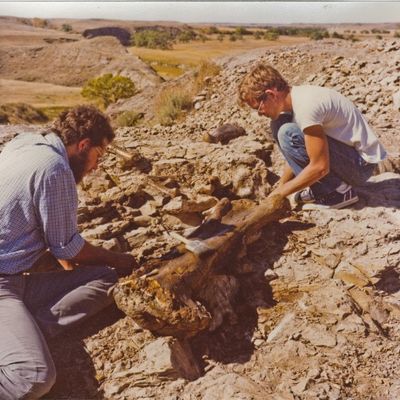
Dinosaur 13 will infuriate you, which is saying a lot for a movie about paleontology and the finer points of U.S. property law. It starts off in August 1990, near Faith, South Dakota, when a group of scrappy, veteran fossil hunters from the Black Hills Institute discover some articulated vertebrae in a rock face, revealing what appears to be an intact Tyrannosaurus rex skeleton. Patiently, but anxiously, they dig down into the cliff with picks and shovels, in 115-degree temperatures, over days and days, slowly excavating the teeth, the skull, the tail. Sure enough, it turns out theyÔÇÖve found the full skeleton of a T. rex, perhaps the most impressive paleontological find of our time. They pay the landowner $5,000 for the rights to the find ÔÇö the most ever paid up until that time. Then they load up the skeleton ÔÇö again, taking great care, learned from years of expertise, despite the fact that they donÔÇÖt hold Ph.D.s or have fancy degrees ÔÇö and take it home to Hill City, South Dakota, where they hope to display it in a big, brand-new museum, putting this small, unknown town on the map.
The care they put into their efforts is touching: They spend a year just removing individual bones from around the skull as they detail all the damage that this dinosaur, whom they call Sue (after Sue Hendrickson, the paleontologist who discovered her), must have sustained during her ÔÇ£terrible, rough life.ÔÇØ We see home-movie footage of the paleontologists separating the jawbone from the pelvis, and even though we canÔÇÖt really make out whatÔÇÖs happening, the film has done such a good job of placing this find in context, and also giving us mini-portraits of these individuals ÔÇö particularly Peter and Neal Larson, the co-founders of the Black Hills Institute ÔÇö that we share in their triumph.
And then an army of FBI agents shows up, with the National Guard in tow, and all hell breaks loose.
The government alleges that the Black Hills Institute stole this fossil from U.S. federal land. With the kind of manpower usually reserved for drug kingpins, they seize Sue ÔÇö making the paleontologists themselves pack the bones back up, so they canÔÇÖt be damaged ÔÇö and┬á take her away, intending to hold her while the whole mess gets sorted out in court. A small group of townspeople ÔÇö women and children, mostly ÔÇö chant ÔÇ£Shame on you!ÔÇØ as the governmentÔÇÖs trucks take the fossil away.
But thatÔÇÖs just the beginning of the whole thing. Dinosaur 13 astutely depicts the bewildering and maddening legal stew of claims and counterclaims that ensued, eventually entangling the Black Hills Institute, the Bureau of Indian Affairs, the academic research community, SothebyÔÇÖs, U.S. Customs law, the show Unsolved Mysteries, and the largest criminal case ever tried in South Dakota. ItÔÇÖs a great story, to be sure, and director Todd Douglas Miller weaves all sorts of fascinating real-life details (including one unlikely love affair) into a clean, involving narrative. You might even find yourself doing that horrible thing of mentally casting the narrative feature as you watch the documentary.
The movie makes you angry, but youÔÇÖre not sure at what. While there are wild miscarriages of justice occurring throughout Dinosaur 13, Miller doesnÔÇÖt try to make any broader points about government overreach or civil liberties, which means that our outrage goes unanswered, sticks in our throat. (Libertarians, though, will find a lot in this movie to mobilize them, as itÔÇÖs a prime example of government coming in and screwing everything up.)
ÔÇ£The race to discover the EarthÔÇÖs past is a very exciting one,ÔÇØ one talking head tells us, ÔÇ£and people want a piece of it.ÔÇØ ThatÔÇÖs probably the crux of the matter here, as the film captures a moment in time when fossil exploration went from being the passion of small communities of scientists and surveyors to big business. (For example: Nobody mentions it, but at some point during this timeline of events, Jurassic Park came out, helping cement dinosaursÔÇÖ place in the pop-cultural firmament.) But Miller only hints at such themes, preferring to let them linger in the air ever so briefly. For all its stridency, Dinosaur 13 isnÔÇÖt looking to mobilize us or get us to think hard about these issues. It just wants to tell its wild, one-of-a-kind tale in the most engaging way possible, and it does that exceptionally well.


